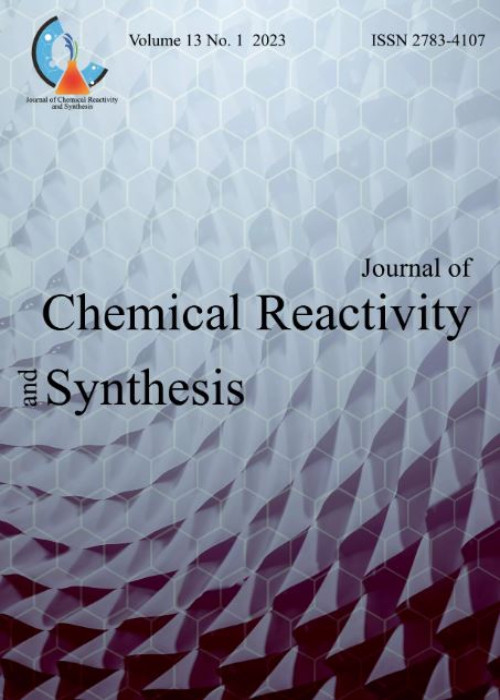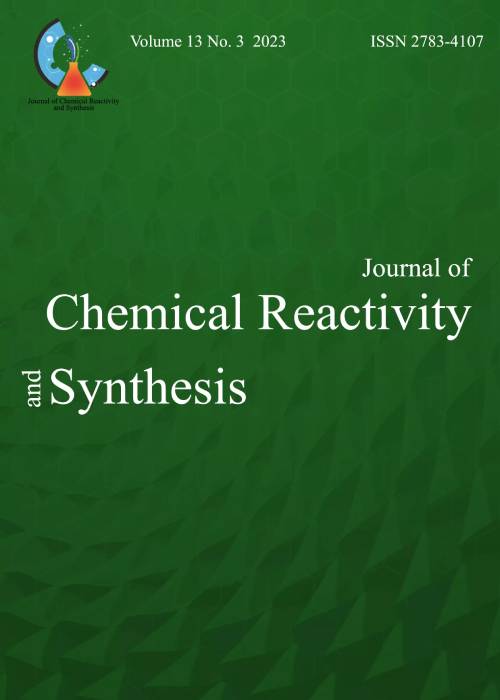فهرست مطالب

Journal of Chemical Reactivity and Synthesis
Volume:13 Issue: 1, Winter 2023
- تاریخ انتشار: 1402/02/11
- تعداد عناوین: 6
-
Pages 1-19Here we provide a report on the synthesis, structural recognition and tautomeric behavior of a new series of coumarin-based hydrazide-hydrazones (4-methylcoumarin-7-yl-oxymethyl arylaldehyde acetohydrazones) and their 1,3,4- oxadiazoline and oxadiazole derivatives. The final products were tested for antibacterial activity on both Gram-negative and Grampositive bacteria. Both types of hydrogen, the hydrazone N-H and methylene protons can take part in tautomeric isomerization equilibrium. The synthesis of 1,3,4-oxadiazoles and oxadiazoline bearing coumarin ring was conducted for inferring the isomerization-tautomerization of their hydrazone precursors According to the NMR investigation, We found that, the amide-iminol tautomerization is more probable than keto-enol one. It was further explained via converting the hydrazones to the corresponding 1,3,4-oxadiazoles and oxadiazolines based on the modified procedures. All the synthesized oxadiazoles and oxadiazolines have antibacterial effect on Gram-negative bacteria with respect to Gram-positive bacteria. The active ingredient of the synthesized derivative 8 has the best effect on both Gram-negative and Gram-positive bacteria.Keywords: 4-Methylcoumarin, Oxadiazoles, Anti-bacterial agents, Heterocycles
-
Pages 20-33In this research, homo and copolymer electrosynthesis of Aniline/Pyrrole changed into performed at the tip of a graphite pencil in phosphoric acid containing KCl as electrolyte support. The ability of electro-synthesized homo and copolymers to reduce Fe3+ turned into compared and evaluated. Fe is a ferromagnetic material that exhibits magnetic properties in the absence of a magnetic field. Fe+3 ions are very pale due to the unauthorized mutation of the electrons, and with the reduction and conversion to Fe+2, there is a permissive electron mutation, which means that the chelates are rapidly attached to the authorized ligands and increase the color Fe (III), as an oxidant, tends towards the antioxidants found in the sample and makes contact with them and turns electrons into Fe (II) and tripyridyltriazine (TPTZ) is an electron binder in which by the electron donor antioxidant. The consequences show that the poly-aniline decreasing assets are better than the copolymer and that the copolymer is higher than the polypyrrole. The FTIR and UV-visible spectra indicated that the aniline ring increase in the polymer chain escalated the reduction. The structure and morphology of the homo and copolymer have been confirmed by SEM and FTIR.
-
Pages 34-50The hydrothermal method synthesized the first cobalt ferrite and cobalt oxide nanoparticles in this article. The synthesized nanoparticles were then subjected to various analyzes such as X-ray diffraction patterns, scanning electron microscopy images, infrared spectroscopy, and vibration sample magnetometer to ensure their properties and prepare the nanoparticles for the next step. Then, 6% by weight of nanoparticles were added to the epoxy resin as a reinforce, and a polymer matrix composite was made. After making the composites according to the ASTM D638 standard, they were subjected to a tensile test. The results showed that the nanoparticles were prepared very fine, uniform, high purity, and had good magnetic properties. Also, hydrothermal was a suitable method for the synthesis of these nanoparticles. Furthermore, samples made using cobalt ferrite nanoparticles offer better tensile properties than samples made with cobalt oxide. However, in general, the tensile properties of composites have improved compared to pure polymers.Keywords: Nanoparticle synthesis, Hydrothermal Method, Cobalt ferrite, Cobalt oxide, polymer matrix composite
-
Pages 51-65
This study focused on their usefulness as a nano demulsifier. KIT-1 was characterized via FT-IR, XRD, SEM and Nonyl phenol ethoxylates (n = 6, 12 and 20 denoted as NPE-6, NPE-12 and NPE-20 respectively) surfactants were used with commercial demulsifier. The result showed that composition of KIT-1 and nonyl phenol ethoxylates (NPEs) in crude oil emulsion greatly improve the demulsification efficiency of the original demulsifier. It was found that the best demulsifier composition for breakdown of crude oil emulsion was the one based (NPE-12) and KIT-1. The results clearly showed that the sample with the best water separation performance would raise demulsification efficiency to a value of 95%.
Keywords: Water in crude oil emulsions, Demulsifiers, Demulsification efficiency, Nonyl phenol ethoxylates, Disordered mesoporous silica KIT-1 -
Pages 66-85
The review surveys the development of kinetics and various oxidizing agents which can be used during the study of chemical kinetics along with oxidation of some organic substrates by hexacyanoferrate (III) /HCF (III). Since HCF (III) is acting as relatively poor oxidant, it acts as a selective outer-sphere reagent applicable for most of the easily oxidizable substrates and normally it is used as free radical interceptor; because of which it converts into a species acting as an efficient one electron oxidant mainly for the octahedral complexes in comparative study.
Keywords: Oxidation, Organic compounds, metal, catalyst, Selective -
Pages 86-92
A new bio-friendly catalyst was synthesized via impregnation of coconut chaff. Maghemite-coconut chaff (MCC) showed an excellent capability for catalyzing the Mannich reaction in the water as a clean solvent. MCC was easily separated from the reaction medium with a magnet due to its ideal magnetic activities. Moreover, the catalyst showed an outstanding recyclability potential. While the catalyst structure and its properties were investigated by XRD, SEM, and VSM, organic products were fully identified by IR, CNMR, and HNMR.
Keywords: Fe2O3, Coconut chaff, Mannich reaction


